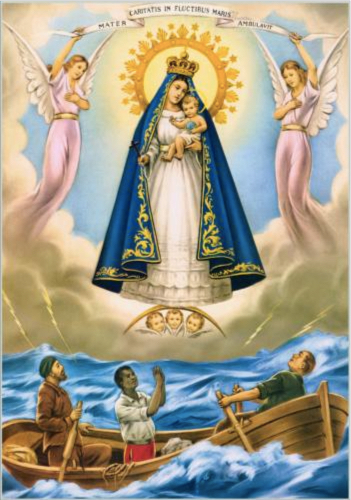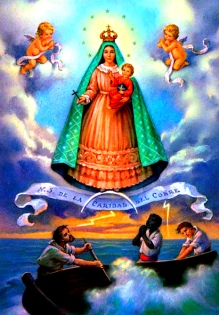
Prayer
Hail Mary! What joy in my soul, oh loving Virgin Mary, what sweet thoughts arise in this greeting. May my heart be filled with jubilation at reciting the Hail Mary and recalling your fiat at hearing the Angel’s message that you would bear a Son, Our Lord Jesus Christ.
O beloved Virgin Mary, my Mother, I consecrate myself to you today: my eyes, my ears, my tongue, my heart, in other words, my whole being. I am yours, Oh Mother of Mercy, guard me and defend me as your son/daughter. Amen.
Ask for your petition here
REMEMBER, O most gracious Virgin Mary, that never was it known that anyone who fled to thy protection, implored thy help, or sought thy intercession was left unaided. Inspired with this confidence, I fly unto to thee, O Virgin of virgins, my Mother; to thee do I come; before thee I stand, sinful and sorrowful. O Mother of the Word Incarnate, despise not my petitions, but in thy mercy hear and answer me. Amen.
History
The history of the La Vírgen de la Caridad del Cobre, began around 1612. The image is thought to have been brought by Spaniard colonists from the town of Illescas, a province in Toledo, Spain where a similar statue of the Virgin Mary of Charity was already well-venerated.
Local legend recalls the Spanish captains who bring with them religious Marian images to guide and protect them from English pirates at sea. Two Native American or Indian brothers, Rodrigo and Juan de Hoyos, and an African slave child, Juan Moreno, set out to the Bay of Nipe for salt.[2] They are traditionally given the moniker the “three Juans”. They needed the salt for the preservation of the meat at the Barajagua slaughter house, which supplied the workers and inhabitants of Santiago del Prado, now known as El Cobre. While out in the bay, a storm arose, rocking their tiny boat violently with incoming waves. Juan, the child, was wearing a medal with the image of the Virgin Mary. The three men began to pray for her protection. Suddenly, the skies cleared, and the storm was gone. In the distance, they saw a strange object floating in the water. They rowed towards it as the waves carried it to them. At first they mistook it for a bird, but quickly saw that it was what seemed to be a statue of a girl. At last they were able to determine that it was a statue of the Virgin Mary holding the child Jesus on her left arm and a gold cross in her right hand. The statue was fastened to a board with an inscription saying “Yo Soy la Vírgen de la Caridad” or “I am the Virgin of Charity.” Much to their surprise, the statue remained completely dry while afloat in the water.
The story began sometime around 1612 with three slaves: two young native American brothers and a twelve-year-old boy of African origin. They have gone down in history as “los tres Juanes.” The three were workers in the mines, and had taken a canoe into the sea off the north coast of Cuba in search of salt. As they went along they saw something riding on the water some distance away. At first they first thought it was the body of a bird, but as they got closer they saw to their surprise that it was an image of the Blessed Virgin, resting on a small piece of wood, holding the child Jesus and dressed in a beautiful cloth gown. Written on the wood were the words: “I am the Virgin of Charity.” The statue, despite being tossed about on the waves after a recent storm, was completely dry when they recovered it. They brought the image back to their small town, and it was eventually installed in a chapel in a village called “El Cobre” because of its proximity to the copper mines. A special devotion developed there toward Our Lady of Charity “del Cobre” and soon spread to the rest of the island.
Source: https://primematters.com/foundations/enrichment/la-virgen-de-la-caridad-del-cobre
